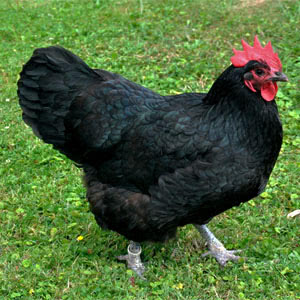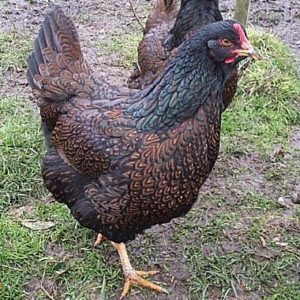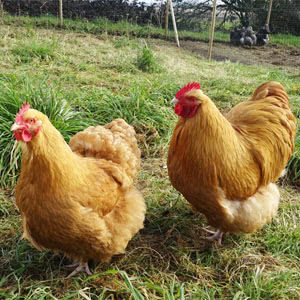BROWN LAYERS
- AUSTRALORP
- BARNVELDER
- BIELEFELDER
- BLACK/RED STAR
- BRAHMA
- BUCKEYE
- CHANTECLER
- DELAWARE
- JAVA
- JERSEY GIANT
- MARAN
- NAKED NECK
- ORPINGTON
- PLYMOUTH ROCK
- RHODE ISLAND RED
- SPECKLEDY AKA
SPECKLED RANGER - SUSSEX
- WELSUMMER
- WYANDOTTE

Australorp
These birds are known for their excellent egg production. You’ll easily get 250 light brown eggs per year. The record holding hen laid 364 eggs in a 365 day period, without assistance of artificial lighting!
 Barnvelder
Barnvelder
Barnvelders are named after the Dutch town of Barnveld. They are a medium sized, dual-purpose bird. They are hardy and make good foragers. They lay a fair number of dark brown eggs, are good winter layers, and have a calm disposition.
The original and most well-known variety of this breed is the Double-laced pattern. They have beautiful plumage, with each feather having copper, black, and metallic green coloring. They make an excellent addition to a backyard flock, and are quite the conversation piece!
 Bielefelder
Bielefelder
The Bielefelder is a modern breed, developed in the early 1970s in Bielefeld, Germany. Poultry breeder Gerd Roth used genetics from a number of breeds including the Cuckoo Malines, Amrock, Wyandotte, and New Hampshire. The Bielefelder managed to retain the best qualities of all these breeds. Consider this breed another example of extraordinary German engineering. They check off all the boxes on your “perfect chicken” wish list.
This dual-purpose breed is autosexing so males and females can be identified immediately upon hatching. Females have a chipmunk strip on their backs, while males are lighter in color and have a yellow spot on their heads. They mature to have a complex feather pattern which is best described as cuckoo red partridge.
Birds are very friendly and seek human interaction. They have a large frame that holds plenty of meat. Roosters can weigh 10 – 12 pounds! Their size and camouflaging feather pattern makes them perfect for free-range conditions.
Hens can produce upwards of 230 large eggs per year. Their eggs are a unique shade of brown with pink undertones that you won’t find anywhere else.
 Black Star / Red Star
Black Star / Red Star
Red Stars and Black Stars are hybrids that have been bred to have their color at hatching linked to the sex of the chicken (pullet or cockerel). This makes chick sexing an easier process, and you as the purchaser are less likely to be surprised! Ever had a pullet start to crow one day? Not with these birds!
They’ve also been developed to be extremely good egg layers. Don’t be surprised if you see 300 eggs in a year! Egg color and size will vary, depending on the cross-breeding.
Black Stars are a cross between a Rhode Island Red rooster and a Barred Rock hen. Red Star’s are a cross between a Rhode Island Red rooster and either a White Rock, Silver Laced Wyandotte, Rhode Island White or Delaware hen.
 Brahma
Brahma
Often referred to as the “King of All Poultry”, the Brahma chicken is appreciated for its great size, strength, and vigor. By 1901, birds were documented to have reached the incredible weights of 18 pounds! This breed, together with the Cochin, fueled what became known as “Hen Fever” – a national obsession for poultry that hit both America and England around 1850.
Brahmas are an excellent addition to a backyard flock. They are hardy chickens in winter climates, they cannot fly over low fences (because of their size), and they have calm and docile personalities. The best part, they lay the majority of their eggs October thru May! That means while the rest of your girls may slow or even quit production for the winter, your Brahmans will keep the egg cartons full of large, medium brown eggs.
One thing to keep in mind, Brahmas are not ideal for hot climates. Their anatomy makes them susceptible to overheating. So, if you keep Brahmas, make sure to keep them cool in summer!
 Buckeye
Buckeye
The Buckeye breed was created by Mrs. Nettie Metcalf in Ohio in the late 19th century. In fact, the Buckeye is the only American breed of chicken developed solely by a woman. She crossed Buff Cochins and Barred Plymouth Rocks to create a large, lazy fowl, and then added some Black-Breasted Red Game birds.
Buckeyes are a dual-purpose breed of chicken with a lustrous red color. They have pea combs (distinguishing them from Road Island Reds), are cold-weather hardy, and adaptive to a variety of living conditions. These active, friendly birds are well-known for their abilities to hunt and catch mice!
 Chantecler
Chantecler
In 1907, a monk, Brother Wilfrid Châtelain, noticed that no breeds of chicken had yet been established in Canada. All the birds were from Europe or America. He set out to change this and create a practical chicken that would be suited to Canada’s climate, and be an excellent dual-purpose bird. By 1918, he debuted the Chantecler.
Chanteclers are large birds with white plumage that lays tight against the body. They have exceptionally small cushion combs and wattles, which attributes to them being one of the most hardy breeds. They are fairly tame, but do not thrive in confinement, so consider this breed for free ranging. They lay about 200 brown eggs annually.
 Delaware
Delaware
Delawares were developed in 1940, in Delaware, by George Ellis. The were originally known as “Indian Rivers.” The breed originated from crosses of Barred Plymouth Rock roosters and New Hampshire hens. Although originally intended as a meat bird, Delawares make an excellent dual purpose bird. They are known to have a calm and friendly disposition, and lay jumbo brown eggs – about 4 per week in ideal conditions. Plus, let’s not forget to mention their beautiful plumage!
 Java
Java
The Java is the 2nd oldest chicken breed developed in America, going back to 1835. Its ancestors come from the island of Java in the Far East. Javas are an excellent breed for free-ranging homesteads and are known for their egg production and table qualities. Javas come in white, black, mottled, and auburn. The Black Java is known for the brilliant beetle-green sheen of its feathers.
 Jersey Giant
Jersey Giant
The Jersey Giant chicken was developed between 1870 and 1890 in New Jersey. You can probably guess that these birds are pretty big! Roosters weight in at 13 pounds, and hens can easily grow up to 10 pounds! They are the largest purebred chicken breed.
They are known to be fairly good layers compared to other large breeds, and are good winter layers. Expect about 260 large brown eggs per year.
 Maran
Maran
Marans originated in western France and were imported in the 1930s. There are 9 recognized colors: Cuckoo, Golden Cuckoo, Black, Birchen, Black Copper, Wheaten, Black-tailed Buff, White and Columbian. If you find Marans chicks at a feed store, they will most likely be the Black Copper or Cuckoo variety. Hens are active and enjoy free ranging, and also have friendly, outgoing personalities.
Marans are renowned for their dark chocolate brown eggs. If you’re looking for unique eggs, these are quite the conversation peace! You’ll get about 150-200 each year in your nesting boxes.
 Naked Neck
Naked Neck
The Naked Neck is a breed of chicken that is naturally devoid of feathers on its neck and vent. The breed is also called the Transylvanian Naked Neck, as well as the Turken. The name “Turken” arose from the mistaken idea that the bird was a hybrid of a chicken and the domestic turkey.
They make for a good dual-purpose utility chicken. They only have about half the feathers of other chickens, so they are easier to pluck if raised for meat. They also lay a respectable number of eggs. They are very good foragers and are immune to most diseases, plus they are pretty fun to look at!
 Orpington
Orpington
Orpington chickens were developed in the town of Orpington, England of all places! During the late 1800s, William Cook wanted to create a new breed that was dual purpose, but had white skin, which the British preferred for meat. Within 10 years, Orpingtons were a favorite in both England and America, and came in a variety of colors – black, white, buff, jubilee, and spangled.
Orpingtons lay about 200 eggs per year. If you’re thinking about adding some to your flock, we suggest the Buff Orpington. They are known for being very docile – they make great pets!
 Plymouth Rock
Plymouth Rock
Developed in America in the middle of the 19th century, this breed of chicken is historically the most popular in the United States. Up until WWII, no other breed was kept as extensively as the Plymouth Rock. The original birds were all of the Barred variety – with black and white stripped plumage – and other color varieties were developed later. The popularity of this duel-purpose breed came from its qualities as an outstanding farm chicken: hardiness, docility, broodiness, and excellent production of brown eggs. This chicken is usually what comes to mind when you think of the chickens Grandma used to keep!
 Rhode Island Red
Rhode Island Red
Rhode Island Reds are a great choice for beginner chicken-keepers, or expert small flock keepers alike! Developed in Massachusetts and Rhode Island in the late 1800s, these birds are a hardy, dual purpose breed. They are very low maintenance, and can tolerate less than favorable conditions. Hens lay about 5 – 7 eggs per week.
 Speckledy aka Speckled Ranger
Speckledy aka Speckled Ranger
Are you ready for your new favorite breed? The Speckledy is a modern hybrid, resulting from a cross between a Rhode Island Red rooster and a Marans hen.
They are elegant in build, with feathering that resembles a Cuckoo Marans. The feathers are silky, soft to the touch, and quite abundant and fluffy. They have pale bay eyes, pale legs, a medium-sized single comb, and small earlobes and wattles.
They are a docile, easy to tame, and easy to handle bird. They are good foragers and well suited to a free-range environment.
Speckledys are very good layers. Hens will lay 250-270 chestnut brown eggs per year, which are often speckled. Their eggshells are particularly strong and the yolks are a deep yellow. They may produce less than some other hybrids, but they will keep your egg cartons full!
 Sussex
Sussex
This breed has ancient connections going all the way back to 43 A.D., when the Romans invaded Britain. They grew a reputation of being the finest poultry in Britain, and reached America in 1912. They are a dual-purpose breed and will put on fat very easily, so be careful in feeding them too many treats! If they become too overweight, you will see a decline in egg production. Sussex chickens are a wonderful breed for a small farm or homestead, being active and all-around an excellent breed for meat and eggs. Hens lay an average of 250 light brown eggs each year, and come in three recognized color varieties: Speckled, Red, and Light.
 Welsummer
Welsummer
Welsummers are a Dutch breed of domestic chicken, developed in the 1920s. It is a light, friendly, and intelligent breed, with rustic-red and orange color. Hens lay large eggs, that are a dark, terracotta brown, and often speckled. Roosters are considered to have the “classic rooster” look, and often used in media.
 Wyandotte
Wyandotte
Developed in the 1880s, Wyandottes are named after a Native American tribe prevalent in parts of upstate New York and Ontario, Canada. They are thought to be developed from the Dark Brahma and Spangled Hamburgs.
The Silver Laced Wyandotte was the original color recognized, but since then black, blue, buff, buff Columbian, Columbian, golden laced, partridge, and silver pencilled have been added as recognized color varieties.
Wyandottes are friendly, calm, and cold hardy. Hens lay on average 200 light brown eggs per year. They make excellent setters and mothers.
Comments
Post a Comment